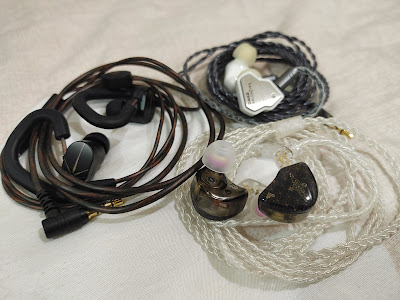As the year comes to an end, 2022 has been a remarkable year for people getting into the hobby - not so for collectors' wallets, however. In this year alone, much of the previous IEMs sitting within budget (<$50) territory have been replaced by newer releases. Gone are the days where the default recommendation is Blon BL-03 for newcomers, and gone are the days where tonally balanced budget IEMs were scarce. As the year comes to an end, I thought it would be good to give my thoughts on the Tangzu Wan'er S.G, the latest addition to my collection and compare it with other budget IEMs released this year in my possession. If you are just entering the hobby, perhaps this may be useful in luring you over the fence into choosing your entry IEM without breaking the bank. Below are my impressions on the sound and other practical aspects of the Wan'er, which do not include outward appearance nitpicks. For this review, comparisons will be made when describing the different ranges.
Tangzu Wan'er ($20)
Lows
The bass region of the Wan'er can only be described as neutral-warm, engaging, and tastefully tuned. If you've heard the Salnotes Zero ($20) or the Moondrop Chu ($20), the Wan'er's bass instantly comes across as a notch higher in quality. While some may enjoy the lean bass on the Zero since it forwards the upper midrange relatively, the lack of adequate midbass can make bass guitars sound limp. In comparison, the extension of both subbass and midbass ensures that even horns sound full without being too overbearing. On first listen, it may seem that the Wan'er's bass is sluggish, but it is more evident that fuller low end lends more weight to low tones, and this includes male vocals.
Midrange
The midrange of the Wan'er is a familiar sound within the budget greats. Like the Zero and Chu, the midrange is neutral with no particular problem areas. However, the higher midbass shelf leads to a not-as-clean separation between lows and midrange on the Wan'er in comparison to the Zero or Chu. Regardless, there is no bass bloom nor bleed which unfortunately exist on older, more expensive sets. Male and female vocals are more even in presentation compared to both the Zero and Chu, though minor nitpicks can be made on crowded tracks with deeper male vocals. Colors of the Heart - Uverworld is an example where Takuya's vocals aren't separated as well from the mix as compared to higher pitched male vocals like The Sixth Lie. No gripes with the female vocals though. Interestingly, I find kick drums and snares to sound less dominant on the Wan'er compared to both Zero and Chu, which can swing both ways depending on how you like your music.
Treble
This is where the Wan'er sets itself further apart from the Zero and Chu. The Chu was known to have a somewhat hollow yet metallic treble in the upper frequencies, which was later corrected on the tamer Zero. The Wan'er slows it down even further by having a more relaxed treble. The result is a smooth, non-fatiguing listening experience without most of the instrumental harmonics being too audible unless you intentionally crank the volume up. In a way this is fantastic with tracks that tend to be treble-spicy. A prime candidate is Acacia by Bump of Chicken, which literally has accompanying hi-hats throughout the entirety of the song (worse still, with little variation). On the Wan'er, the track is perfectly listenable with a warmer overall tonality versus the brighter Zero. On the Chu, I skip this track completely. Suffice to say, if you love treble and care less about the other frequencies, then the Wan'er is definitely not for you.
Technicalities
Similar to the Zero and Chu, the Wan'er has what I consider to be more linear staging. Instruments aren't really layered well, and they spread out across a straight line. Overall, not an out-of-your-head experience, but not mashed together as well. Detail retrieval is decent, as with clarity. In this aspect, I find the Zero to be the superior one. Other than that, there is nothing to fault the Wan'er at this price.
Conclusions
It is probably safer to assume that more companies have finally caught on to proper tuning on budget DDs. This is great for the hobby, though this also means tuning aspects may no longer be as easily discernable for future releases since they will likely be minor variations of each other. The Wan'er, to me, has the most balanced tonality out of the three, and probably a reference tuning standard for future releases. The Wan'er is (for now) my default recommendation to anyone wanting to enter the hobby. For existing audio people who already own either Zero or Chu, the Wan'er exists more as a tonal sidegrade rather than upgrade. If we ignore price, then the Wan'er is... alright. Include price in the equation and the Wan'er is immediately launched up the pedestal.
Score: 6.75 B-
Value: S (safe to blind purchase)
Personal enjoyment: 6.5 (Zero and Chu: 6)
Pros
- Smooth, safe tuning to handle most music genres
- Meatier bass presentation (relative to Zero and Chu)
- Non-fatiguing treble
Cons
- The cable is war crime level, coupled with qdc connectors to ruin your day
- Mediocre treble extension and energy
- Particular male vocal ranges may not sound as clean


Comments
Post a Comment